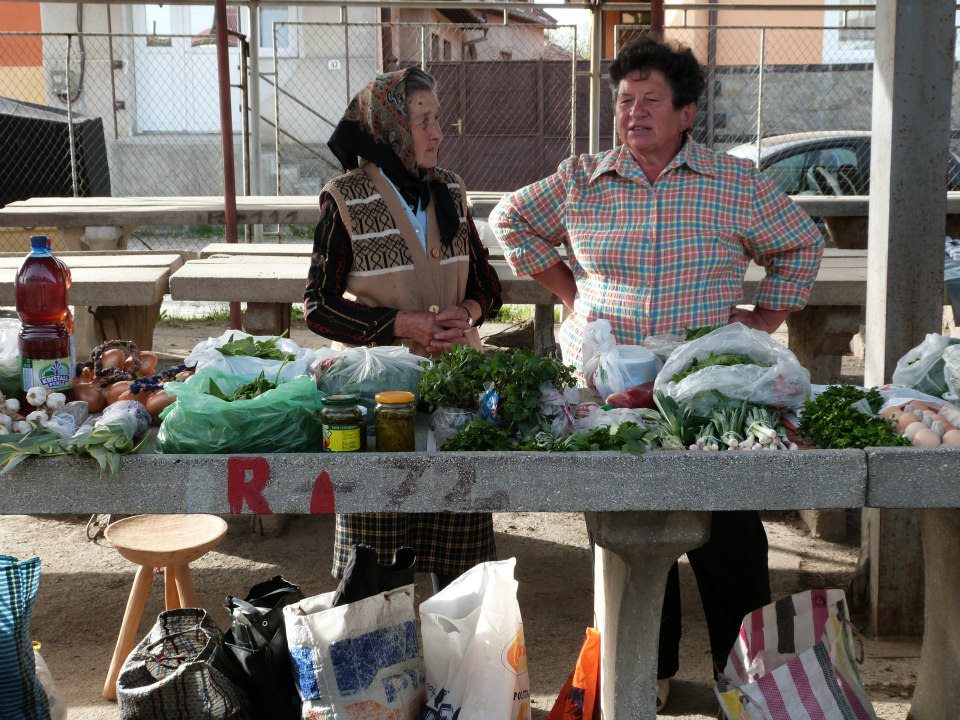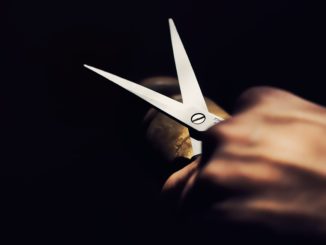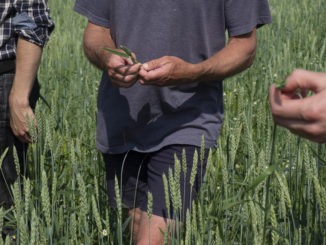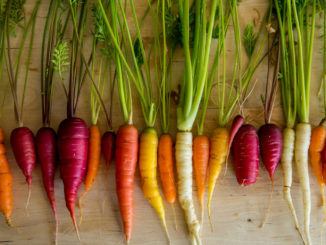
The Huedin Market has been around for over 100 years. Starting in the 1950’s, it was adapted to fit Communist standards and policies. After Communism, it has continued to connect local producers and consumers but modern trends and regulations endanger some of the traditional ways of growing and selling food. Peasants have had to fight for their right to sell at the market in Huedin, as Derek Freitas, Food Sovereignty Campaign Coordinator for Eco Ruralis, explains.
Ramona Duminicioiu, myself and an intern for Eco Ruralis‘ Food Sovereignty Campaign, Ulysse Le Goff, recently visited Huedin Market to start our organization’s work on market studies. We made this trip to primarily study how a small town market is run, if access to market is an issue for peasants and small food producers and if the market is economically sustainable for all parties involved.
When we first arrived, we instantly realized that the Huedin Market is not only about food. One passes by many sellers of tools, clothes, household products and cooked food before ever reaching the food market. Thus, the Huedin Market is more or less an attraction for many types of consumers and it can serve as a way for someone to spend half or a full day experiencing all aspects of the market.
Shortly after arriving, we met with the Huedin Food Market Manager named Csabi. He enlightened us about the history of the market and a bit more about the inner workings of the market. However, he did not talk at all about the market’s troubles over the past few years.
He told us that there are around 200 sellers at the market and only about 15 – 25 of them are non-producers at any given time. So, this is a mostly producer market without many middlemen involved … a good thing if you are a small food producer.
The mayor’s office of Huedin controls the market and Csabi is the administrator directly in charge. Public money paid for a new indoor hall to be built a few years ago and this is where all the animal and dairy products are sold as well as some vegetable and fruit products.
Huedin Market’s fees for the producers are low and reasonable according to Csabi. Sellers in the outdoor portion of the market (which has small roofs and cement tabletops) pay just around 2 lei (50 euro cents) per day. It is not obligatory for someone to have a contract to sell outside but if you do sign the contract, you can keep selling in the same spot at the market which usually helps people make better profits. Sellers in the new indoor hall pay around 3 lei (75 euro cents) per day. It is not obligatory for sellers of the indoor market to have contracts but those without them must pay 10 lei (a little more than 2 euros) per day. All producers at the market have a Certificate of Producer document which is required. Every 3 months, a contract must be renewed and approved by the mayor’s office.
Csabi says that there are public funds which pay for the utility costs, construction and repairs needed to maintain the facilities. The refrigeration and heating needed are also reasons why fees are higher in the new indoor hall. He says that the sellers’ fees contribute to these costs and with the public funds the market operates fine in an economic sense. It was not mentioned whether any aspects of the Common Agricultural Policy (CAP) were being utilised by authorities to provide any funding for this market or other town or neighborhood markets in the country but it would definitely help!
Currently, there are some access to market problems. One big drawback is that the outdoor stands are only open on Tuesday (the big market day) and Friday yet the indoor stands and rooms are open every day of the week. This is definitely an access to market issue for some local peasant families who would like to sell on more than two days per week. The competitive advantage goes to those in the indoor market also because there are almost no spots available in the indoor market even if peasants or small producers could afford to pay the fees required. The reason why the indoor sellers can afford to pay these fees is due to the fact that they almost always produce more and may sell in many places. This means that the Huedin Market has a systematic way of supporting bigger sellers in order to receive more revenue from the fees. This sounds a lot more like those in charge of the market are treating it more like a business than a public good that fairly benefits and serves all who participate. And, during the fall and winter, most consumers prefer to buy products from the indoor market due to the cold weather outside. Yet another advantage.
Despite the above issues, there are a couple positive things to mention. There are plenty of outdoor stands open if more sellers would like to come with their products. And the market is still filled up with enough producers so that consumers have a wide variety of products to choose from yet not too much competition.
Csabi says that the EU and Romanian governments’ rules have two sides. The new regulations created by both make everything more organized which is good but it is very hard for every single producer to abide by a uniform set of rules. For instance, new sanitary rules regarding animal-based products are very expensive and small producers can’t afford to pay for the procedures required by law in order to sell at the market.
Csabi confidently mentions that the producers make a sufficient profit at the market but the sellers (inside and outside) said the opposite when we met them. He said that despite the market being okay now, the future is not bright for this market. He mentions “it depends on the economy, not on us. It constantly influences us. We adapt to the economy, it doesn’t adapt to us.”
Now, we turn to an event which changed the course of this market in 2010. The mayor’s office decided to build a new indoor hall for the Huedin Market. A new law was passed that year which designated that fruits, vegetables, dairy and other animal-based products must be sold in a covered building. At first, everyone loved the new building and was excited. But when it opened, the fees were too expensive and sellers were forced to pay fees for the whole year. The big sellers also voiced that they didn’t want the small producers to compete with them in this new facility.
The mayor’s office closed the outdoor market and thus the small producers became displaced. This was a very sad time indeed. People that had been going to the market for 10, 20, 30 years or more were devastated. They were promised one thing and delivered another. Never could they have imagined that they would have no where to sell at all. The closing of the outdoor market was a way for the mayor’s office to enforce milk regulations too. Milk sellers were kicked out of the old market along with everyone else and they couldn’t pay for the fees of the indoor market which include paying for refrigerator space.
A few months went by in 2011 without many of the sellers of the old market selling anything at all at the Huedin Market. Another rule kept many of these sellers from legally selling at the market – the Certification of Producer rule. This was yet another way of modernizing the market but also separating who was allowed to sell and who was not.
In the spring of 2011, some brave former local sellers of the outdoor market came to Huedin and sold their products while sitting on mats on the ground outside the new indoor market. They lost some dignity and knew that they were “illegal” sellers but they decided to break the law because they didn’t feel it was just or fair. Following suit, many more of the former sellers of the outdoor market returned and broke the law too by selling outside without a Certificate of Producer.
In August 2011, a few people made a petition which demanded that the old outside market be re-opened with fair fees for the producers. Almost all of these displaced sellers signed it and the mayor’s office backed down to the public pressure and scrutiny by re-opening it that Autumn. One condition of this was that all sellers had to get a Certificate of Producer, which they did. The public definitely sided with these producers and it shows that unjust laws can be wiped away if the people stand together.
Unfortunately, a few supermarkets and vegetable and fruit shops opened up due to the market fiasco. Now, they are gaining more and more customers each year which is hurting even more the small profits that peasants make at this market.
Eco Ruralis’ team interviewed many producers at the market along with Csabi and a few consumers. Almost all the producers, consumers and Csabi have unfavorable opinions about the future of the market due to new local competition from the supermarkets and other food shops. And there are a bunch of unauthorized sellers who pay no fees which walk around both markets or sell out of their vans in a nearby street. The authorized producers (which pay fees) say that they make very little profit if any from selling at the market and consumers go less to the Huedin Market now. They also complain about the unauthorized sellers because there is enough space in the outdoor market and the fees are reasonable but they refuse to pay anything and steal competition away from the peasants and very small producers. And the police don’t get involved with stopping any of the unauthorized food selling.
Although there have been many issues with access to market and unjust regulations associated with the Huedin Market, the key point is that the public definitely sided with these producers and it shows that unjust laws can be wiped away if the people stand together.
In broader policy terms, these markets are the kinds of things which should be supported by the short food supply chains measures in the Rural Development Programme of the CAP (see som eexamples of this in action in Arc2020’s agroecology project)
Access to market is an important issue and the people of Romania and elsewhere need to pay attention to this more. Eco Ruralis plans on doing more of these studies in the future in order to show if food bought is local, if producers are the primary sellers and if those involved in these markets are being treated fairly and are receiving enough profit for the activity to be economically sustainable.
More from Ecoruralis
- Climate Smart Agriculture: a climate change fairytale
- Billions Spent on Rural Romania – who benefits?
- Summer festivals celebrate rural activism in Romania
- Agritourism’s Expansion into Romania: Food, Fun & Knowledge
- Tough Times for Eastern European migrant workers
- Moldova: East or West, Capitalism Defines its Socio-Economic Terrain
- Will Dacian Cioloş remain as Agriculture Commissioner?
- Want to volunteer on peasant farms? Try WWOOF Romania!
- Pioneer’s GM maize 1507: a case history




